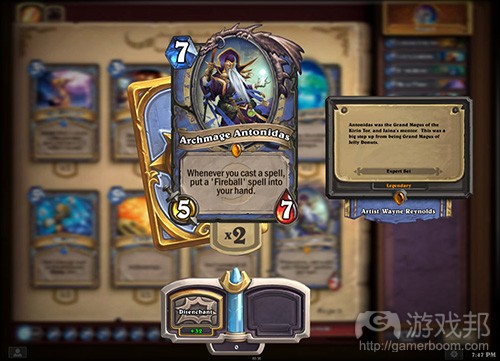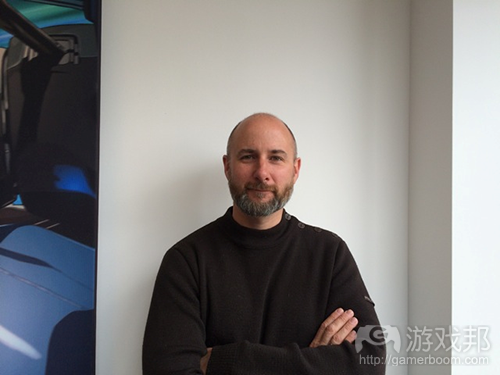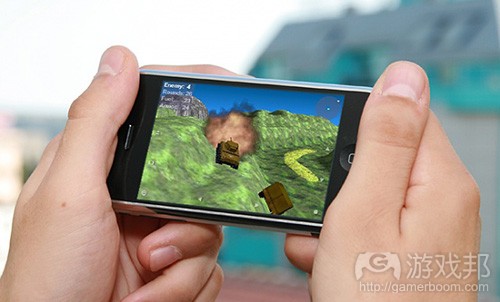每日观察:关注美国跨平台游戏玩家比例增长(7.10)
1)据venturebeat报道,暴雪免费卡牌游戏《Hearthstone:Heroes of Warcraft》如今已不在iPad应用畅销榜单前20名,目前在美国位于该榜单第23名。该游戏4月份登陆iPad平台时表现强劲,但并没有维持这一势头。
这款游戏4月份登陆iPad时迅速跻身47个国家/地区下载榜单首位,但仅在韩国晋升为畅销榜单冠军。它在过去数周时的排名一直在前十位徘徊,直到最近才缓慢下滑。尽管每款游戏最终排名都会下降,但《Candy Crush Saga》等热作却一直在下载量和畅销榜单连续数月位居前列。
现在暴雪正在开发该游戏的Android和iPhone版本,曾允诺会在今年底前发布这些版本。届时这些新版本有可能提升该游戏下载和销量,同时也有助于增加iPad版本销量。除此之外,该工作室还在测试第二款免费游戏《Heroes of the Storm》(《英雄联盟》风格的多人在线竞技战斗游戏),分析师预计这两款游戏在2014年或将为暴雪创收高达2亿美元。
2)据venturebeat报道,游戏咨询公司Digi-Capital最新报告指出,在过去12个月中,游戏公司收购交易超过125亿美元。
Digi-Captial第二季度报告指出,去年移动领域并购交易以46亿美元领先,其次是大型多人在线游戏交易(40亿美元),游戏技术领域为25亿美元,主机领域仅为10亿美元。
3)据gamasutra报道,在日前的Develop大会上,三名免费手机游戏设计师讨论了对免费模式盈利性的看法。Jason Avent(《CSR Racing》工作室Boss Alien总监)认为,F2P行业正转移极具侵略性的初始盈利本性,喜欢游戏的玩家自然乐意为游戏掏钱。他并不认为付费墙是未来趋势,行业应该转移剥削少部分玩家的策略,并将重心转向让更多玩家在游戏中逗留。
手机游戏工作室Jiggery Pokery代表Matthew Wiggins认同这一看法,并称自己情愿拥有1万连续玩两年游戏的用户,也不愿意拥有100万名只是短暂体验游戏的过客。
Hand Circus工作室成员Simon Oliver(代表作是付费手机游戏《Rolando》)目前正在开发免费模式游戏《Seabeard》,他认为设计一款真正持久的游戏是个非常有趣的过程,倾听用户意见和观察他们所感兴趣的东西,有助于开发者创造和改进产品。
4)据pocektgamer报道,Zynga前发行高管Rob Dyer日前加入Tapjoy并担任该公司开发者关系高级副总裁。
在此之前,Dyer曾任PlayStation发行商关系高级副总裁,以及Crave Entertainment和Edios总裁。
5)NPD Group最新报告显示,从2013至2014年,美国跨平台游戏玩家比例从16%增长至22%,而仅在手机上玩游戏的用户仍保持29%的比例。休闲、“核心-主机”、“家庭”、“仅用PC”及社交游戏的玩家均流失了2个百分点。这表明资深玩家会投入400美元购买全新的PS 4设备,他们同样也会在自己的iPhone或Android设备上玩游戏。
智能手机是2013至2014年唯一获得增长的游戏设备类型,在10名玩家中就有7人表示自己在玩手机游戏,其比例比去年增长了4%。
在过去三个月中,玩家在实体游戏上的平均投入为48美元(去年同期为45美元);2013年玩家在数字游戏的平均投入为11美元,现在则增长至16美元。所有领域的玩家在游戏中的投入均有所增长。
6)据venturebeat报道,知名游戏设计师Cliff Bleszinski日前成立新工作室Boss Key Productions。
报道称Bleszinski在今年4月注册了这家新公司,并担任首席执行官,前EA制作人及Guerrilla Games联合创始人Arjan Brussee则担任首席运营官。
其注册文件显示,该工作室将制作在线游戏,“可下载多人交互电脑游戏程序;电脑和电子游戏软件;可下载电脑和电子游戏软件;通过互联网和无线设备下载的电子游戏;游戏领域的可下载电脑应用软件;交互式电脑和电子游戏程序。”
Bleszinski曾是Epic Games最早期的成员之一,也是《Unreal》和《战争机器》系列开发者。他在2012年末离开Epic,当时腾讯已斥资超过3.3亿美元收购了该公司40%的股份。对于Bleszinski和其他Epic元老来说,这是他们重新评估自己职业生涯的机会。(本文为游戏邦/gamerboom.com编译,拒绝任何不保留版权的转载,如需转载请联系:游戏邦)
1)Hearthstone is sliding down iPad’s top-grossing charts — expansion as well as iPhone, Android versions will help
Jeffrey Grubb
Blizzard’s free-to-play collectible card game isn’t blazing as hot as it once was, but the developer’s plans for Hearthstone should help.
Hearthstone: Heroes of Warcraft, which has players facing each other in one-on-one competition online, is no longer in the top 20 highest-grossing iPad apps. Right now, in the U.S., it is No. 23. That’s not terrible, but it puts it well outside the realm of something like developer King’s Candy Crush Saga puzzler or even its Pet Rescue Saga in terms of monkey-making power. Hearthstone debuted strongly for iPad in April, but it isn’t maintaining its momentum as well as other top mobile releases. This doesn’t mean Blizzard doesn’t have the cards in its hands to make a comeback.
In a note to investors, Cowen & Company analyst Doug Creutz noted the slipping popularity of Hearthstone, but he explained how it could still end up as one of the bigger mobile games over the next quarter.
“With a significant ‘Adventure Mode’ content update coming this summer, we expect the game to return to the top 20 before the end of Q3,” Creutz wrote in a note to investors this morning. “We also believe the planned smartphone versions of the game will be successful.”
When Hearthstone launched on iPad in April, it quickly shot to the top of the download charts in 47 countries. That includes important markets like the U.S., U.K., Brazil, South Korea, and Russia. Despite that, out of those, it only reached No. 1 on the top-grossing charts in South Korea. Instead, it hovered near the top 10 for a few weeks before slowly sliding to its present ranking. While every game eventually tails off, the top mobile releases (like the aforementioned Candy Crush Saga) maintain a presence at the top of both the download and grossing charts for months at a time. Hearthstone hasn’t done that, and one of the reasons for that is probably because it is only on iPad as far as mobile platforms go.
Hearthstone originally debuted for PC and Mac. The iPad release followed a few months later, and now Blizzard is working on a version for iPhone as well as Android smartphones and tablets. The company previously promised to deliver those versions before the end of the year. This will obviously make the game available to more people. That should give a boost its download and grossing numbers, but it may also help increase its iPad sales. People who have Hearthstone with them on their phones when they’re on the go might remember to continue their progress on their iPads when they get home. The availability on iPhone and Android will also bring more people into Hearthstone, and that may increase its visibility in social situations.
While the iPhone and Android versions are important, the upcoming expansion Curse of Naxxramas is just as crucial. With it, Hearthstone is not only getting fresh content, but it’s getting its first single-player adventure. That could attract a different kind of player who wants to try Hearthstone but isn’t sure about only playing online multiplayer.
Hearthstone is a very important product for Blizzard. The developer has routinely generated millions in revenue annually thanks to its megapopular, subscription-based game World of Warcraft. That massively multiplayer online hit has been slowly losing players over time. It once had 12 million paying members, but it is now hovering around 7.6 million. While that is still making plenty of money for Blizzard, it is clearly looking for other sources of cash to help ensure its financial future. With that in mind, it debuted Hearthstone as its first free-to-play game as well as its first major mobile release.
The studio is also now already testing its second free-to-play game, Heroes of the Storm, which is its League of Legends-style multiplayer online arena battler.
Analysts expect that Hearthstone and Heroes of the Storm could combine to make Blizzard as much as $200 million in 2014.(source:venturebeat)
2)Five things that drove $12.5B in game company acquisitions in the past year
Dean Takahashi
In the past 12 months, more than $12.5 billion in game company acquisitions have been announced, according to a report by game advisory firm Digi-Capital.
London-based Digi-Capital said in its second-quarter report that mobile led the way with $4.6 billion in deals in the past year, followed by $4.0 billion in massively multiplayer online game deals, $2.5 billion in game technology deals, and $1 billion in console deals. There are five drivers to this “consolidation crush,” said Tim Merel, managing director at Digi-Capital.(source:venturebeat)
3)’We need to move away from exploiting a small number of people’
By Mike Rose
Three notable free-to-play mobile game designers sat down to chat at Develop Conference today, each with the opinion that monetization in free-to-play is slowly but surely leaving behind that idea of grabbing players quickly, milking them for cash, and then moving on.
Jason Avent, director at CSR Racing studio Boss Alien, has had plenty of experience when it comes to monetization in mobile games. This industry veteran believes that mobile players have changed the way they spend money in games now, and as such, mobile studios have had to change tack.
“I think we’re moving away from the aggressive initial monetization,” he says. “Those people who love your game are happy to pay for it. It’s getting people into that longer game.”
“I don’t think paywalls are the future,” Avent adds. “We need to move away from exploiting a small number of people, and instead work to make lots of people stick around.”
Matthew Wiggins of mobile studio Jiggery Pokery agrees, adding that, “I would rather have 10,000 people who play my game for two years, than a million people who only play for a short time.”
“The kiss of death for mobile is being able to pay to win,” he notes. “What that means is that you don’t even want to have anything that hints at that. You want players to not even be able to think that a game is pay to win.”
There are psychological effects going on in this area now, he reasons. “People look at a free game and say, ‘There’s going to be a catch here.’ So for us, we think about ways that players can extend the game and express themselves.”
Simon Oliver of Hand Circus is in an interesting position. He originally built premium mobile games like the Rolando series, and is now finding that building free-to-play title Seabeard is proving very different.
“Designing a really long lasting game was something we hadn’t done before, it’s really interesting,” he says. “Listening to the audience and seeing what they love. We can now build something like a skeleton and watch it grow.”(source:gamasutra)
4)Zynga’s head of publishing Rob Dyer joins Tapjoy’s developer relations team
By Jon Jordan,
Tapjoy has tapped up Zynga’s ex-head of publishing Rob Dyer as its new senior vice president of developer relations.
Prior to Zynga, Dyer was SVP, publisher relations at PlayStation, and before that he was president of Crave Entertainment and Eidos.
“We’re incredibly excited to have Rob Dyer join the Tapjoy team as our SVP Developer Relations,” said Tapjoy CEO Steve Wadsworth.
“Bringing in someone of Rob’s caliber and diverse experience adds yet another well-versed industry veteran to our executive leadership team.
“Rob’s experience with both publishing and platform companies will have a significant impact on how we continue to drive value for our clients and partners.”(source:pocketgamer)
5)Smartphones are making console-only gamers rarer despite PS4 and Xbox One
Jeffrey Grubb
The PlayStation 4 and Xbox One have both reached millions in system sales, but they aren’t preventing people from also adopting other devices for gaming.
People who play on multiple platforms is the only segment of gamers that is growing, according to a report from industry research firm The NPD Group. That chunk of the market, which NPD calls “omni gamers,” grew from 16 percent to 22 percent of the total gaming population in the U.S. from 2013 to 2014. The biggest group, mobile-only gamers, maintained its 29 percent hold on the market. Casual, “core-console,” “family,” “PC-only,” and social gamers all lost up to 2 percentage points. This suggests that even as dedicated gamers drop $400 on new PlayStation 4s, they are also spending time gaming on their iPhone or Android devices.
In fact, smartphone was the only type of gaming device to experience growth from 2013 to 2014. More than 7 out of 10 gamers reported that they play games on their phones. That is up 4 percent from last year. Consoles and PC did not experience overall growth, even if individual platforms like PlayStation 4 and Steam did.
While gamers are using their smartphones more, spending per player is up for both digital and physical. The average gamers spent $48 on physical games in the last three months, that’s up from $45 over the same period last year. For digital, it is up to an average of $16 from $11 in 2013. Gamers in almost all segments are also spending more time with their purchases.
“Across both digital and physical formats, spending has increased from last year for consoles, portables, and digital gaming apps, which is great news when also combined with the fact that gamers are spending more time playing games,” NPD analyst Liam Callahan said. “Being able to understand the segments that are driving the changes in behavior towards purchasing and time spent gaming is fundamentally important to navigate this complex time in the gaming industry.”
With spending still strong and engagement still high, consoles and PC are still in a strong position with gamers, but it’s clear that smartphones are only capturing more time, more money, and more players with each passing year. And the competition for consumer cash may boost creativity in game development as well as software distribution.(source:venturebeat)
6)Gears of War designer Cliff Bleszinski starts new game studio: Boss Key Productions
Dean Takahashi
Renown game designer Cliff Bleszinski has created a new studio called Boss Key Productions, according to a news report from game site Polygon.
Bleszinski filed for the new business in April with the North Carolina Department of the Secretary of State, said the report. The document lists him as the registered agent of a company in Raleigh, N.C. The papers list Bleszinski as CEO and former EA producer and Guerrilla Games cofounder Arjan Brussee as chief operating officer.
Contacted by GamesBeat, Bleszinski said in an email, “I find it promising and exciting that there’s such interest in what I do next that people are willing to look up from their Bud Lite and hot dogs and fireworks and continue to talk about what I may be doing next in my professional career.”
Brussee cofounded Killzone developer Guerilla and served as production director there for nine years. Their history together goes back to the 1990s—Brussee helped Bleszinski on his Jazz Jackrabbit game, which came out in 1994.
Another document filed with the United States Patent and Trademark Office on May 30 lists Boss Key’s goods and services, suggesting the studio will produce online titles, or as the filing reads: “downloadable multiplayer interactive computer game programs; computer and video game software; downloadable computer and video game software; downloadable electronic games via the Internet and wireless devices; downloadable computer application software in the field of games; interactive computer and video game programs.”
The Boss Key site also opened today.
On Monday, Bleszinski tweeted that he was coming out of retirement to work in the game business again.
Bleszinski was one of the earliest employees at Epic Games, the maker of the Unreal and Gears of War shooter series that have sold millions of copies. He retired from Epic in late 2012 after nearly two decades of making games, not long after China’s Tencent invested more than $330 million for a 40 percent stake the publisher. For Bleszinski and other longtime Epic employees, that sudden liquidity made them fabulously wealthy and gave them a chance to evaluate their careers. Bleszinski, who was a celebrity designer who frequently appeared in photo ops with the Gears of War chainsaw gun, decided it was time to move on.(source:venturebeat)












































